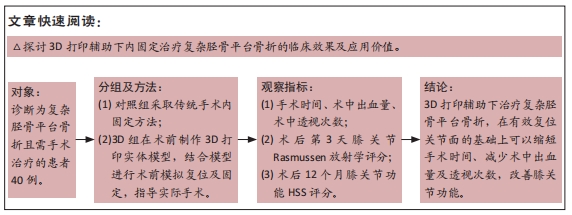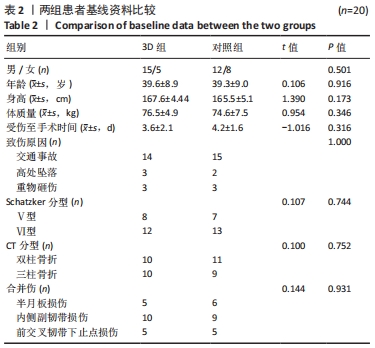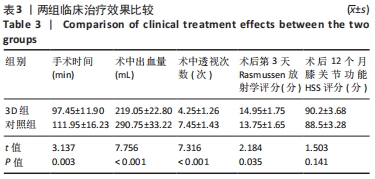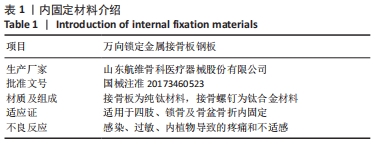[1] 张英泽.临床创伤骨科流行病学[M].北京:人民卫生出版社,2014.
[2] JIANG L, ZHENG Q, PAN Z. Comparison of extended anterolateral approach in treatment of simple/complex tibial plateau fracture with posterolateral tibial plateau fracture. J Orthop Surg Res. 2018;13(1):303.
[3] KFURI M, SCHATZKER J. Revisiting the Schatzker classification of tibial plateau fractures. Injury. 2018;49(12):2252-2263.
[4] CHEN P, SHEN H, WANG W, et al. The morphological features of different Schatzker types of tibial plateau fractures: a three-dimensional computed tomography study. J Orthop Surg Res. 2016;11:94.
[5] YUWEN P, LV H, CHEN W, et al. Age-, gender- and Arbeitsgemeinschaft für Osteosynthesefragen type-specific clinical characters of adult tibial plateau fractures in eighty three hospitals in China. Int Orthop. 2018; 42(3):667-672.
[6] MILLAR SC, ARNOLD JB, THEWLIS D, et al. A systematic literature review of tibial plateau fractures: What classifications are used and how reliable and useful are they? Injury. 2018;49(3):473-490.
[7] 张擎柱,万乾,张义,等.3D打印技术辅助改良后内侧倒L入路切开复位内固定术治疗复杂胫骨平台骨折的疗效分析[J].中华实用诊断与治疗杂志,2018,32(11):1091-1093.
[8] 牛鸣,马飞,马菊蓉,等.基于3D打印的个性化截骨技术与传统方式行全膝关节表面置换的临床对比[J].南方医科大学学报,2017, 37(11):1467-1475.
[9] 张英泽.胫骨平台骨折微创治疗策略与进展[J].中华创伤骨科杂志, 2017,19(10):829-832.
[10] BIZZOTTO N, TAMI I, SANTUCCI A, et al. 3D Printed replica of articular fractures for surgical planning and patient consent: a two years multi-centric experience. 3D Print Med. 2015;2(1):2.
[11] MARONGIU G, PROST R, CAPONE A. A New Diagnostic Approach for Periprosthetic Acetabular Fractures Based on 3D Modeling: A Study Protocol. Diagnostics (Basel). 2019;10:15.
[12] MARONGIU G, PROST R, CAPONE A. Use of 3D modelling and 3D printing for the diagnostic process, decision making and preoperative planning of periprosthetic acetabular fractures. BMJ Case Rep. 2020; 13(1):e233117.
[13] 左睿,孙永建,吴毅,等.3D打印与虚拟手术设计在复杂胫骨平台骨折手术治疗中的应用[J].中国骨与关节损伤杂志,2016,31(4): 369-372.
[14] 霍莉峰,倪衡建.数字骨科应用与展望:更精确、个性、直观的未来前景[J].中国组织工程研究,2015,19(9):1457-1462.
[15] YANG P, DU D, ZHOU Z, et al. 3D printing-assisted osteotomy treatment for the malunion of lateral tibial plateau fracture. Injury. 2016;47: 2816-2821.
[16] GIANNETTI S, BIZZOTTO N, STANCATI A, et al. Minimally invasive fixation in tibial plateau fractures using an pre-operative and intra-operative real size 3D printing. Injury. 2017;48:784-788.
[17] 刘颖,刘显东,曹万军,等.持续被动运动对胫骨平台骨折术后膝关节功能恢复的影响[J].中华物理医学与康复杂志,2017,39(7): 531-533.
[18] HENKELMANN R, SCHNEIDER S, MÜLLER D, et al. Outcome of patients after lower limb fracture with partial weight bearing postoperatively treated with or without anti-gravity treadmill (alter G®) during six weeks of rehabilitation - a protocol of a prospective randomized trial. BMC Musculoskelet Disord. 2017;18(1):104.
[19] ALBUQUERQUE R PE, HARA R, PRADO J, et al. Epidemiological study on tibial plateau fractures at a level I trauma center. Acta Ortop Bras. 2013;21(2):109-115.
[20] GROSS AE, KIM W, LAS HERAS F, et al. Fresh osteochondral allografts for posttraumatic knee defects: long-term followup. Clin Orthop Relat Res. 2008;466:1863-1870.
[21] 袁功武,聂宇,刘曦明,等.3D打印技术辅助治疗与传统手术方法治疗复杂胫骨平台骨折的对比研究[J].创伤外科杂志,2018,20(5): 324-328.
[22] 徐云钦,李强,申屠刚,等.复杂胫骨平台骨折术后并发膝关节僵硬的高危因素分析[J].中国骨与关节损伤杂志,2015,30(4):364-367.
[23] 朱勇,蔡立峰,贾万贵,等.改良前外侧入路治疗累及后柱外侧的胫骨平台骨折[J].临床骨科杂志,2018,21(1):94-95.
[24] 何志勇,张擎柱,林影影,等.传统手术与应用3D打印技术后手术治疗复杂胫骨平台骨折的疗效比较[J].中国矫形外科杂志,2016, 24(8):682-686.
[25] 徐亚风,罗从风,王驭恺,等.累及后柱的SchatzkerⅡ型胫骨平台骨折手术治疗失败的原因分析[J].临床骨科杂志,2015,18(6):722-725+728.
[26] PRAT-FABREGAT S, CAMACHO-CARRASCO P. Treatment strategy for tibial plateau fractures: an update. EFORT Open Rev. 2016;1(5):225-232.
[27] 吴云峰,尹勇,黄斐,等.3D打印技术在复杂胫骨平台骨折临床诊治中的应用[J].中华解剖与临床杂志,2015,20(4):347-349.
[28] YANG L, SHANG XW, FAN JN, et al. Application of 3D Printing in the Surgical Planning of Trimalleolar Fracture and Doctor-Patient Communication. Biomed Res Int. 2016;2016:2482086.
[29] HUNG CC, LI YT, CHOU YC, et al. Conventional plate fixation method versus pre-operative virtual simulation and three-dimensional printing-assisted contoured plate fixation method in the treatment of anterior pelvic ring fracture. Int Orthop. 2019;43:425-431.
[30] 董乐乐,郭鹏年,左强,等.3D打印骨折模型在胫骨平台骨折Schatzker分型中的应用[J].中国骨与关节损伤杂志,2016,31(8): 860-861.
[31] 高迪,张清,刘融.3D打印技术在胫骨平台后柱骨折诊治中的应用优势与展望[J].中国组织工程研究,2020,24(6):911-916.
[32] 周武,曹发奇,刘国辉,等.3D打印技术辅助手术对复杂胫骨平台骨折治疗的价值[J].中华骨科杂志,2017,37(17):1100-1105.
[33] 周明,丁文斌,刘全,等.3D打印技术在复杂胫骨平台骨折手术中的应用研究[J].骨科,2019,10(1):31-36.
[34] 邱伟建,肖鹏,吴学建.改良与传统前外侧入路治疗Schatzker Ⅱ型胫骨平台骨折比较[J].中国矫形外科杂志,2019,27(16):1455-1460.
[35] 侯传勇,刘新晖.改良前外侧入路锁定钢板内固定治疗孤立性后外侧胫骨平台骨折疗效分析[J].中国骨与关节损伤杂志,2020,35(6): 629-630.
[36] 刘璠.胫骨平台骨折治疗相关问题与思考[J].中华骨科杂志,2016, 36(18):1149-1150.
[37] LOWE JA, TEJWANI N, YOO BJ, et al. Surgical techniques for complex proximal tibial fractures. J Bone Joint Surg Am. 2011;93(16):1548-1559.
[38] 陈涯,许长鹏,王法正,等.3D打印与虚拟现实设计在胫骨平台骨折的应用[J].中国矫形外科杂志,2020,28(14):1324-1327.
[39] XIANG L, ZHOU Y, WANG H, et al. Significance of preoperative planning simulator for junior surgeons’ training of pedicle screw insertion. J Spinal Disord Tech. 2015;28(1):E25-29.
[40] 郑晓晖,张国栋,黄华军,等.基于三维编辑的四肢骨折快速虚拟复位[J].中华临床医师杂志(电子版),2015,9(4):617-622.
[41] 裴国献.3D打印技术:骨科最新冲击波[J].中华创伤骨科杂志,2015, 17(1):8-9.
|





